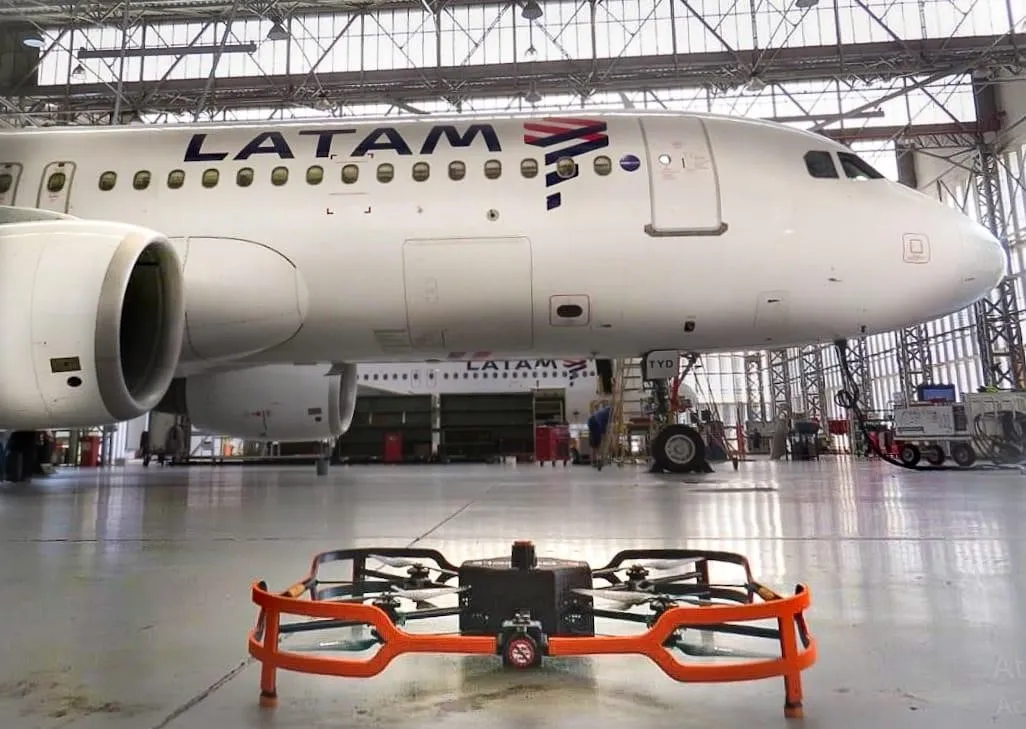
LATAM uses drones to cut inspection times
May 30, 2022

LATAM has embraced drone technology to enhance its operational efficiency, particularly in the realm of inspections. By deploying drones, the company significantly reduces the time required for routine checks and assessments, allowing for quicker identification of potential issues and maintenance needs. This innovative approach not only streamlines processes but also minimizes the need for manual inspections, which can be time-consuming and labor-intensive. The use of drones facilitates more accurate data collection and analysis, ultimately improving safety and reducing operational disruptions. This initiative reflects LATAM's commitment to leveraging advanced technology to optimize its services and maintain high standards in the aviation industry.
In recent years, the aviation industry has witnessed significant advancements in technology, particularly in the utilization of drones for various applications. LATAM Airlines, a prominent player in the aviation market, has embraced this innovation to enhance operational efficiency, particularly in the realm of inspections. By integrating drone technology into their workflows, LATAM has successfully reduced inspection times while maintaining high safety standards. This article delves into how LATAM employs drones to streamline their inspection processes and the benefits that come with it.
Understanding Drone Technology in Aviation
Drone technology, also known as Unmanned Aerial Vehicles (UAVs), has transformed the way industries operate. In aviation, drones are primarily utilized for inspections, monitoring, and data collection. Equipped with high-resolution cameras and sensors, drones can capture detailed images and data from various angles, providing a comprehensive view of aircraft conditions. This capability is particularly beneficial for identifying potential issues that may not be visible during traditional inspections.
Benefits of Drones for LATAM Inspections
LATAM Airlines has recognized the numerous advantages of using drones for inspections, which include:
| Benefit | Description |
|---|---|
| Reduced Inspection Times | Drones can complete inspections in a fraction of the time it takes for manual inspections, allowing LATAM to minimize aircraft downtime. |
| Increased Safety | By utilizing drones, LATAM can conduct inspections in hard-to-reach areas without putting personnel at risk. |
| Cost Efficiency | Drone inspections reduce labor costs and allow for more frequent inspections, ultimately leading to better maintenance practices. |
| Enhanced Data Collection | Drones provide high-resolution images and data that can be analyzed for more accurate assessments of aircraft conditions. |
Streamlining the Inspection Process
The traditional inspection process for aircraft often involves extensive manual labor, requiring teams to physically inspect each aircraft component. This can be time-consuming and prone to human error. LATAM has implemented drones to automate and expedite this process significantly. By deploying drones, LATAM can efficiently scan the entire aircraft surface, checking for signs of wear, tear, or other issues that may require attention.
The integration of drone technology allows LATAM to conduct inspections at a much faster pace. For instance, what previously took hours to inspect manually can now be accomplished in a matter of minutes, leading to quicker turnaround times for flights. This efficiency is vital for any airline, as it directly impacts scheduling and customer satisfaction.
Case Study: LATAM's Drone Implementation
LATAM's initiative to incorporate drones into their inspection processes has proven to be a game-changer. In a pilot program, LATAM utilized drones to inspect a fleet of aircraft over several months. The results were compelling:
- Time Savings: Inspection times were reduced by up to 70%, allowing for more aircraft to be inspected within the same time frame.
- Improved Accuracy: The high-resolution imaging capabilities of drones led to the identification of previously unnoticed issues, enhancing overall safety.
- Positive ROI: The investment in drone technology paid off quickly, as reduced inspection times translated to cost savings and increased operational efficiency.
The Future of Drone Inspections at LATAM
As LATAM continues to refine its drone inspection processes, the airline is exploring further applications of drone technology. Future advancements may include integrating artificial intelligence (AI) to analyze inspection data more effectively, enabling predictive maintenance and proactive issue resolution.
Moreover, as drone regulations evolve, LATAM aims to expand the use of drones beyond aircraft inspections. Potential applications could include ground operations monitoring, cargo inspections, and even emergency response scenarios. This versatility makes drones a valuable asset for the airline's overall operational strategy.
Conclusion
In conclusion, LATAM Airlines' innovative use of drone technology to cut inspection times has set a new standard in the aviation industry. By leveraging the benefits of drones, LATAM not only enhances its operational efficiency but also prioritizes safety and cost-effectiveness. As the airline continues to explore the potential of drones, it paves the way for a future where technology and aviation work hand-in-hand to deliver superior service and safety. The integration of drones is a testament to LATAM's commitment to staying at the forefront of industry advancements and providing the best possible experience for its passengers.
Related Articles

Explore Thailand: The Best Islands to Visit for Paradise, Adventure, and Relaxation

The Ultimate Guide to the Best Islands in Thailand for Your Next Getaway

Do babies need passports? How to get a passport for a newborn

How to get a U.S. passport fast: here’s how to expedite the process

What is Mobile Passport Control: 5 reasons why you should use it

SENTRI vs. Global Entry: A detailed guide

Do you need a passport to go to the Bahamas? Let’s find out

Do you need a passport to go to Mexico? A detailed guide

Do you need a passport to go to Canada? We got the answer

Do You Need a Passport for a Cruise: An Essential Travel Guide

Booster Seat Requirements: All the Rules to Follow in Your Rental Car

What Are the World’s Most Powerful Passports, and How Does Yours Rank?

How to Take a Passport Photo at Home: A Helpful Guide

You've got to have heart! Southwest's new livery

Your opinion: Should water be free on low cost carriers?

Young women bolder than guys as solo travellers
